When to prune, how to prune, where to prune? There’s no other task that strikes fear into the heart of most amateur gardeners as does the subject of pruning plants.
Yet successful pruning can be among the most satisfying of garden tasks, because the results can be spectacular. Done correctly, it can yield an abundance of flowers, foliage, and fruit.
However, done incorrectly, it can result in damaged plants, disappointment, and failure! No wonder we fear the process.
While pruning successfully may appear complicated and difficult, the fact is that it is no more complex than the many other gardening activities that gardeners engage in regularly.

We link to vendors to help you find relevant products. If you buy from one of our links, we may earn a commission.
It’s all about learning the correct methods for each type and variety of plant. There are distinct differences and the answer lies in what all good gardeners already know: Understand each and every one of your plants and what they need to thrive.
Along with quality soil, the right lighting, and essential nutrients, good pruning is just another tool in the gardener’s toolshed and one that has some easy basic steps to master. Good pruning will result in a healthier, more vigorous garden.
What You’ll Learn
What Is Pruning?
First of all, let’s define what pruning actually is and what it can do to help your plants. While you don’t have to be a master gardener to understand the entire process, you do need to have some basic plant knowledge.
Simply put, when pruning, a gardener is controlling the plants growth and development into specific patterns. Each shoot (or branch) on a woody plant ends in what is known as the terminal bud, below which other buds (or future branches) are positioned in specific patterns that are different for varying species of plants.
There are four basic arrangements of budding: alternate, opposite, spiral, or whorled.
The terminal (end) bud is where the branch is growing longer and is the lead bud on the shoot. This bud produces a chemical that slows the growth of the buds behind it on the shoot.
If the terminal bud is removed by pruning, pinching, or breaking off, the supply of that chemical is slowed and the other buds (which will form what are called lateral shoots) quickly grow and branch out, resulting in a bushier look to the plant instead of a long spirally growth.
That sounds pretty simple right? Well, it’s a bit more complicated than that, depending upon the individual species.
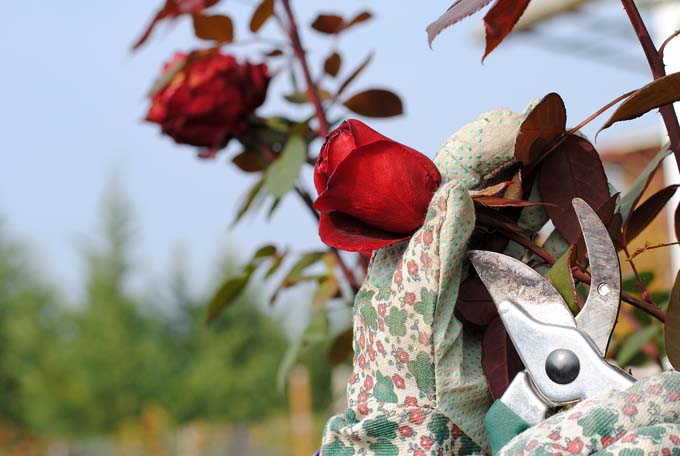
For the most part, pruning always stimulates growth, but how severely you prune a plant will depend on exactly what you want to happen.
If a plant has not been regularly pruned and has been left to grow in whatever pattern comes naturally, that plant may need what is called a severe cutting back which will result in lots of new shoots and fast growth the following spring.
Severe pruning (or cutting way back) will typically result in vigorous growth but light pruning will allow slower growth.
Why Prune?
There are people who claim that pruning goes against the natural growth pattern of the plant and has a potential to actually damage the plant, opening up a cut that allows disease to flourish. Plants do get sick and need surgery just like people.
The argument to prune states that a garden is a managed or controlled environment, and as such, each plant co-exists in relation to other plants in the landscape.
There are times when it is absolutely necessary to prune to encourage healthier growth and to rejuvenate shrubs and plants. And then of course, there is the ornamental element.
Gardeners often want a balanced symmetry to their garden plots, borders, and hedges. Pruning well will encourage that groomed and well-cared-for look in a garden.
Of course, successful planting is key here also.
Knowing how large a plant will eventually become is important. There are plants that require much more space than the gardener allowed for them at planting time and no amount of pruning will squeeze them into a smaller space allotment – and in fact may truly damage the plant.
We’ve all seen the beautiful tiny bonsai trees, but that is a special technique. Most garden shrubs have their spacing requirements based on mature dimensions. Plan carefully as you plant.
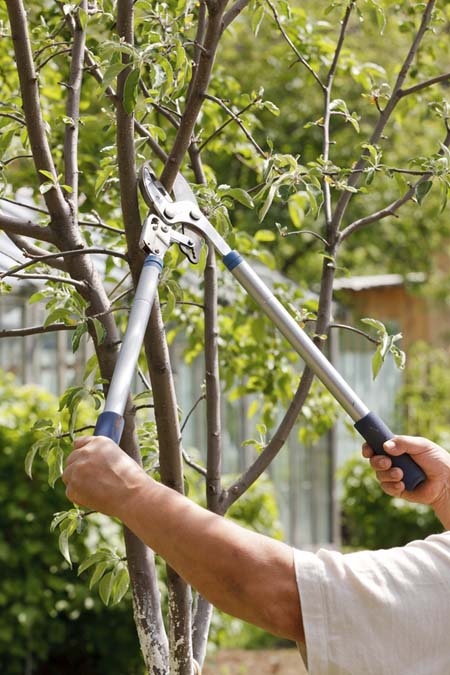
The argument against pruning causing disease is that cuts on young plants typically heal quickly. Four or five years of pruning on young establishing plants can get them into a great shape and basic framework that will only require occasional light pruning to maintain.
Again, knowing your plant and what shape, space and design you want it to have in your garden is important in knowing how and when to prune the plant.
However, even the most unrestricted of older plants will benefit some form of annual trimming to keep them healthy and productive of fruit and flower.
Annual cutting removes old wood to allow young shoots to flourish and become stronger as well as encouraging good airflow to prevent fungal disease from taking hold. Flowers, like roses, have larger blooms on young shoots than on old shoots.
Annual or renewal pruning results in plants that remain compact and youthful. Dead, damaged, and diseased shoots and branches need to be cut all the way back to healthy wood.
These shoots need to be disposed of in the trash or by burning – if permitted in your locale – to get rid of any infection or disease and prevent its spread in the garden. Correct pruning is one of the most essential methods of restoring a sick plant to good health.
When to Prune
It is accepted theory that the best time to prune is during the dormant period. In most growing zones in the United States this is the period between late fall and early spring. Winter pruning stimulates growth, while summer pruning slows it down.
However, on flowering shrubs, when you want to stimulate the most beautiful flower growth, pruning immediately after blooming is the best way to encourage full and abundant flowering growth the following spring. There are some plants that for various reasons are best served by spring, summer, and early fall pruning.
Grapes, birch trees, and maple trees are examples. So again, knowing your goal and when to prune your plant is essential for best results.
Talking with your nursery, consulting online plant information, or finding a good basic gardening book on pruning will help you find specific information for every plant you purchase.
Tools for Pruning
Very few tools are needed for normal garden pruning but purchasing good quality equipment is a solid investment for the amateur gardener. There are several important items to have in your toolkit.
A good pair of secateurs (or hand pruners as they are often labeled). Three main kinds are available: anvil, bypass, and parrot-bill. All of them should have a safety catch that locks the blades in a closed position.
Don’t buy cheap ones! They will break and not make the good quality cuts you need in successful pruning.
The anvil type has a straight edged cutting blade. The bypass has a curved blade that cuts against a curved fixed blade, and the parrot bill has two curved edge blades that work like scissors.
When cutting with them, gripping the stem to be pruned off as far back on the blades as possible will ensure a stronger cut and poses less risk of damage to the tool. These hand pruners are for smaller plants and thinner stems.
I would recommend the Felco F-2 for the best quality and for a set that should last for a life time. They’re Swiss made and great for rose bushes, flowering bushes, and plants. You can read our review of the Felco F-2 here.
Felco F-2 Hand Pruner on Amazon
For those with smaller hands, the Felco F-6 is a better choice.
Felco F-6 Hand Pruner on Amazon
For larger shrubs and small trees, a long-handled pruner is essential for cutting the thick stems. We use two main types in our home garden, a hand shear with long blade and handles, and the long handled pruner (aka “lopper”).
Long bladed hedging shears work well for trimming evergreen shrubs and hedges. Fiskars Garden Powergear2 Hedge Shears are a good choice here.
Fiskars Powergear2 Hedge Shears on Amazon
But when getting into difficult spaces and dealing with very thick stems, long handled pruners supply the extra cutting leverage and strength needed. And again, I’d recommend going with Felco quality.
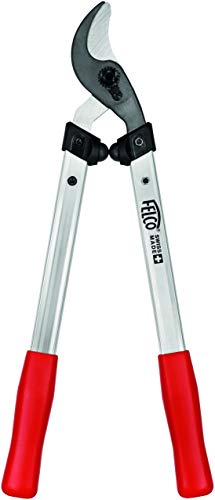
They also allow the gardener to work at a distance from thorny bushes.
Some gardeners like to use pruning saws and knives.
These can require some practice to get used to working with them, and for most beginning or amateur gardeners is not necessary.
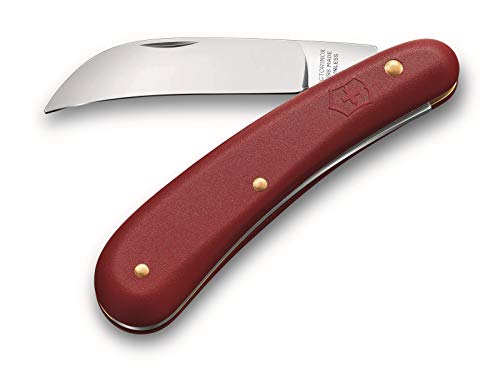
Victorinox Pruning Knife on Amazon
However, for some older fruit trees and older shrubs, a small pruning saw like a Grecian saw that has a curved blade or the English pruning saw with tapered blades and teeth on both edges can be very useful in removing green wood and larger branches.
These should be all the tools necessary to allow you to begin pruning most plants in ordinary home gardens other than perhaps a tool tote.
General Pruning Tips
I recommend that gardeners who need to learn more about pruning to find the specific pruning instructions for each plant in their garden. I consider each plant we add to our garden as an investment and like any investment I want the care manual.
I want to know what it needs to eat and drink, where it likes to rest, in the shade or in partial sun or full, and how it needs to be groomed (pruned).
Doing some basic research before you buy a plant is a good idea for all gardeners. Because pruning is best done as a young plant grows, learning what type and how to prune your plant is key. And make sure to allow enough space for mature dimensions at planting time.
In the following segments, I give some examples of different basic garden plants and how to prune each one from initial planting to routine maintenance. There are also some great garden books available and I will highlight a few that we own.
Pruning Roses
Every gardener knows how incredibly beautiful a rose bush can be or how straggly and homely an uncared-for rose can be! And for this article, it’s also important to note that while roses could be grouped with other shrubs and climbing bushes, they are such a large category and one that is beloved by many gardeners.
There is also a lot of variation in cultivated rose species – from sprawling giants to petite miniatures, some that bloom at very specific times, and others that bloom the entire summer.
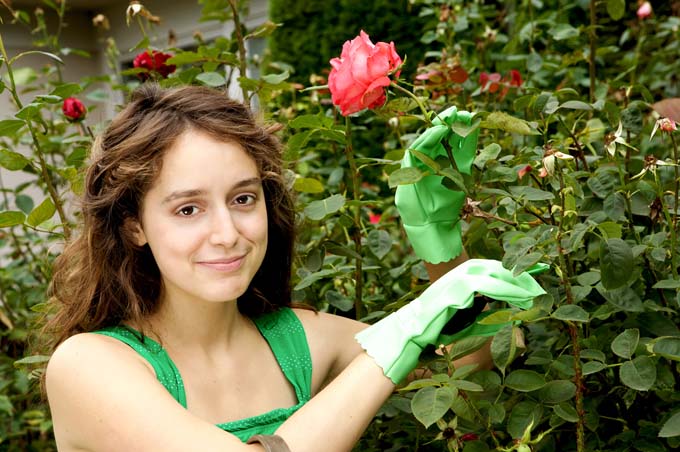
Again, best results will be gained by knowing what your specific rose species requires. But there are three main categories that cover most varieties: modern bush hybrid roses, species and shrub roses, and climbing, rambling types.
Modern Bush Roses
Basic techniques begin with buying plants that have three or four strong shoots and a well developed root system. Before you even plant, be sure to trim long, coarse, or damaged roots.
If you’re planting in autumn or early winter, cut back damaged or unripe growth at the end of the shoots behind the terminal end bud. Just chop them off neatly to allow new bushier growth.
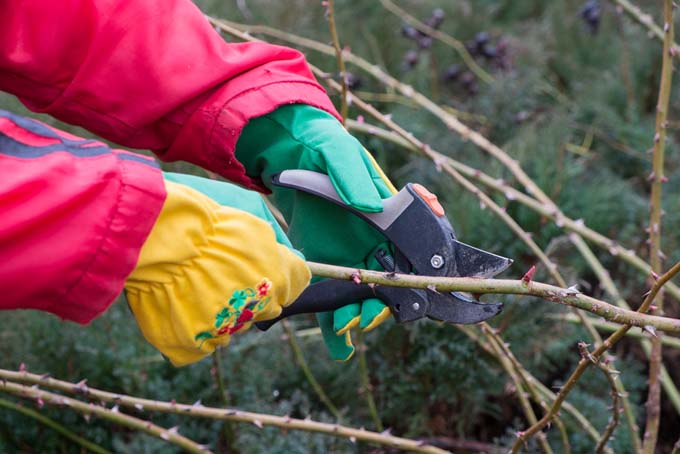
This initial hard pruning will root out any damaged shoots and will encourage vigorous growth in the spring. Inexperienced gardeners often fear “hurting” their new precious rose, but if they don’t give it that hard initial pruning, they will have a weaker plant in the spring.
Cut back to about six inches of shoot before you plant the rose. Follow other good planting techniques as per our guide to growing roses. Then watch your new rose grow throughout the first year of spring and summer.
In mid to late autumn it’s a good time to cut out unripe growth or shoots that didn’t flourish and to tip (cut back) stems carrying faded flowers. In an exposed garden, where a lot of wind blows, it’s a good idea to shorten each stem by about one-third.
This basic maintenance pruning should have you cutting back each stem to a bud that is between six and 10 inches above ground level. Cut back weak growth more severely than stronger stems, and to encourage the replacement of old wood with new, cut one of two main stems of oldest wood right down to the base.
Now on a younger plant, you won’t have as much old wood, maybe not any on a one-year-old rose.
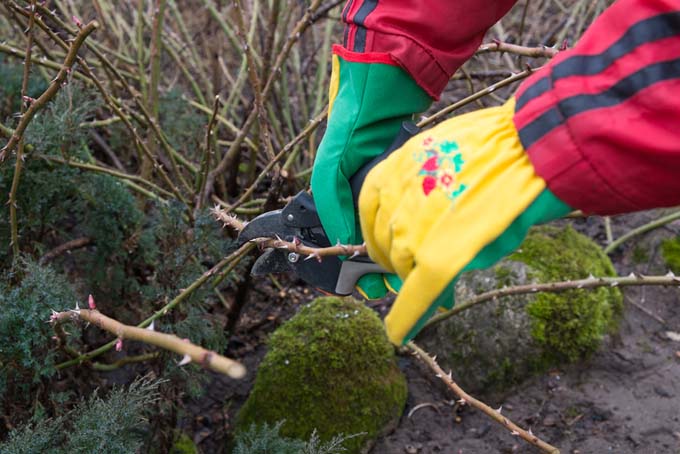
As you make your pruning cuts, look at the direction the stem is growing in and make your cuts angled to allow them to grow out or in. A slight angle on your cut can change the direction of a stem or branch. Look at your rose bush and assess the directions you want the stems to grow.
Remember, roses don’t have to be one round shape, they can branch off with longer main stems and have shorter stems along several longer ones.
You can virtually sculpt the shape of your rose bush by the choice of where and what direction you make your pruning cut.
Hybrid Roses
These roses are deciduous thorny shrubs and they flower in summer and early autumn. Most grow to be three to four feet high with stiff, upright stems and large flowers.
The aim of good pruning is to encourage a good floral abundance, with the bushes planted in beds or mixed in with other ornamental plants.
These hybrids vary in vigor and growth patterns depending upon the breeding behind them, so monitoring these shrubs is important to ensure beautiful flowers and maintain healthy rose bushes.
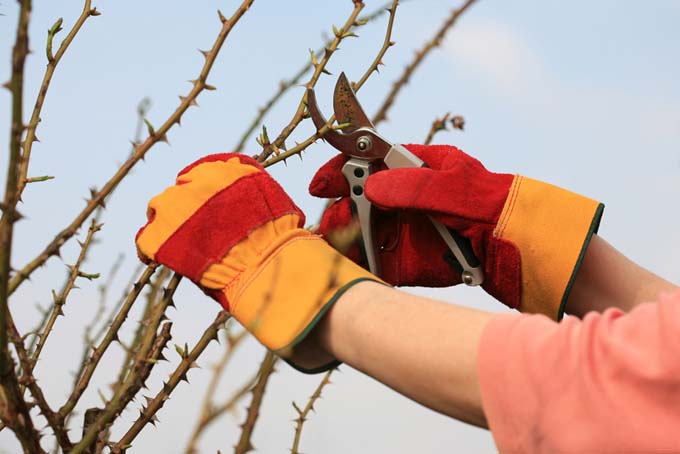
As these roses bloom during the summer months, they are capable of producing more flowers if fading or decaying roses are removed, and the entire stem (or truss) that held the flower is cut off at the first strong well placed eye (or new bud growth).
So when maintaining your rose garden, it’s important to carry with you a short hand pruner to undertake small daily pruning tasks. I also recommend garden gloves, since you will be working with thorny stems.
Species and Shrub Roses
These roses have great variation in size, growth, and flowering performance and generally only bloom once during a growing season.
Because of this, and because these plants generally have a freer and more naturalized look about them, they require less maintenance pruning. Again, before you plant, prepare as above for other rose plantings.
You will not deadhead (remove spent flowers) during the blooming season, and the only pruning you need to do to maintain these plants is light to moderate – to remove diseased branches or stems and to contain the bush to the area you have assigned it.

Prune in late winter or early spring by cutting back up to a third of the vigorous shoots that developed during the preceding growing season. At the same time, you can cut the older wood to about six inches.
You do not want to cut back as far on newer shoots as this could destroy the nice arching aspect of these roses and reduce the flowering in the summer.
Remember, new shoots produce the largest, most attractive flowers. Old shoots support the structure of the plant.
The main purpose of pruning for these plants is aimed to providing space and to cut out older wood to allow the development of new vigorous shoots from the base of the plant.
Your maintenance pruning plan is to remove dead and diseased wood in the late winter or early spring, shorten by a third long new shoots and cut back laterals on shoots that have flowered already to about four to six inches.
And then in mid to late autumn cut back very long growths and of course any diseased stems or shoots that you notice.
Always keeping a lookout for signs of disease when you prune is a good tip. And again, there are so many variations in rose categories, that it’s difficult to pinpoint common practices that affect every single variety.
Knowing and figuring out what each species or rose plant requires is up to the gardener when he purchases and plants a distinct flower.
For instance ‘Nevada’ is a modern shrub rose that needs almost no pruning. If in doubt, contact a good rose breeder and ask for specific pruning techniques for your rose bush.
I always keep a gardening journal with pages for each plant we purchase detailing planting dates, maintenance, nutrition needs, etc.
Climbing Rambling Roses
The final main category of roses are those climbers and ramblers that have very different characters. Some grow large enough to be virtual trees, some bloom only once, others produce prodigious displays of flowers the entire summer.
But all of these respond well to a regular programming of control and management and this is often the only way to accommodate them in any garden!
The result of good pruning is plants that will produce flowers along much of the stem length and not merely at the tip. But this is also the plant that requires the most skill and education on good pruning technique.
Again, there are three main types of ramblers that each require different techniques. Identify which type of rambling rose you have purchased and find out the best technique for your unique variety.
A good example and common rambler in home gardens these days are hybrid tea roses. These repeat flower during a season, show fair to good resistance to disease, and are easily trained against walls and fences. They reach a short height of four to five feet, so are excellent for smaller gardens.
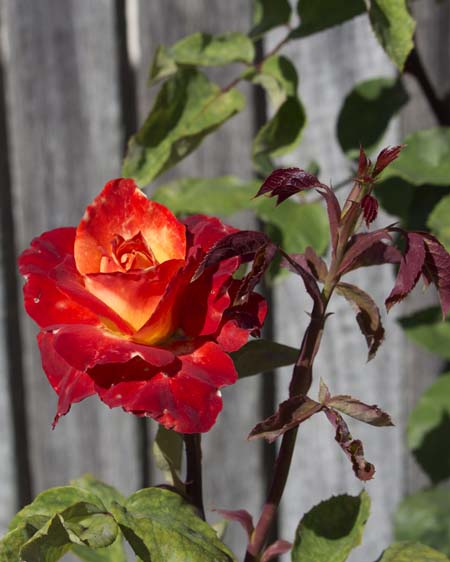
At planting, do not hard prune back stems. Trim any long roots and only tip back damaged ends of stems and any weak side shoots. Begin training the rose as you plant it.
Do not force stiff stems, but whenever possible slant your pruning cuts in horizontal or angled cuts to encourage growth in that direction. Between mid-autumn and spring, after the first year, cut back stems that flowered the previous year to about six inches.
Cutting back these leaders allows new vigorous shoots and occasionally removing old stems at near ground level will encourage even more new growth.
With rambling roses, you need to provide strong support in the form of either tripods, or rustic poles and metal frames, brick walls, or other older trees. Flexible stems can be tied up as necessary to maintain height until the plant itself develops some strong older shoots.
Training climbing roses requires patience and a good eye for direction, support, and art. It’s fun, but challenging and it’s often why gardeners fear these plants in their garden.
Remember, pruning can be done wrong, and the plant will still survive and you start in a different direction with the plant. If all else fails, cut way back and start again!
Read more about pruning roses here.
Pruning Shrubs
Shrubbery is the cornerstone of all garden beds. It’s what gives the garden structure, height, and is the base planting in most beds. Shrubs are either deciduous (lose their leaves each year) or evergreen.
Many ornamental shrubs require only minimal pruning from one year to the next with just the cutting out of dead, diseased or damaged wood as soon as it is noticed.
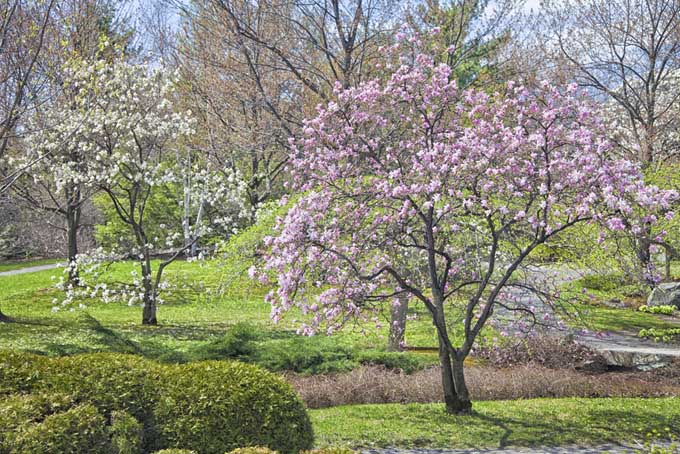
However, some shrubs need regular pruning to enhance the decorative impact of the plant, the flowering strength, and the overall shape of the plant in the gardeners design.
Deciduous Shrubs
As with most plants, focusing your pruning on the early young years of the plant establishes a well balanced framework. Some shrubs do not produce new growth from the base, magnolias and witch hazels being examples of this, and so just giving them a haircut occasionally is enough to keep them looking groomed and healthy.
For these plants, at planting remove any weak growth. And then in the spring of the second year, make any corrective cuts necessary to begin laying out the shape that you desire in the shrub.
Look at the basic plant and remove any laterals or extensions growths that are too closely spaced. This lays the basic framework for how and in what direction your shrub will flourish. In the third and following years, little more than routine pruning to remove dead or diseased wood is required.

These shrubs sometimes will produce what I call an independent shoot that just zooms out from the base. You may be able to train them in to your plan and basic framework, but if it’s not possible, just cut them out at the base to avoid the branches from becoming congested and not having the balance you want.
Many of these deciduous shrubs produce flowers in spring or early summer. Forsythia is a vivid common example. To maintain their profuse floral displays, you should cut out a proportion of the wood in late spring or early summer. If left unpruned, these plants often have lots of twiggy growth and sparse spattering of flowers.
The annual cutting out of dead or old wood allows development of new replacement shoots low down on the shrub and these new shoots will flower freely the following year. This annual pruning keeps the shrub shapely and compact but it’s more imperative to ensure good floral display.
Most plants purchased at a nursery will have had a couple of years of good framework pruning to establish a good structure from the beginning. But as these shrubs flower, new growth develops below the flowering wood.
The strongest shoots are those lowest on the stem, and these are the best to select as shoots when pruning. Leave them and encourage their growth by removing old wood. Cut the old and leave the young is the best rule of thumb for flowering shrubs.
Evergreen Shrubs
Every garden has evergreen shrubs. All of them have widely varying needs for pruning and you should consult your garden store or nursery for exact pruning advice or consult a good gardening book.
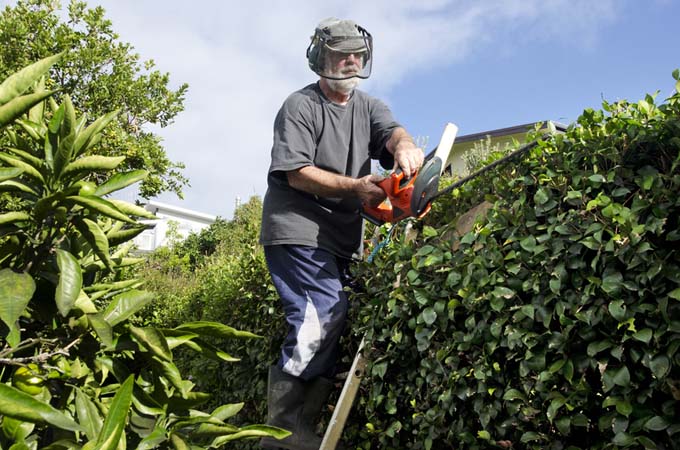
Pruning of evergreens can vary from broadleaf examples like lavender, dwarf conifers, and even camellias and rhododendrons. Most of them require minimal maintenance but again you can’t lump them all together.
If left to their own devices there are a number of small evergreen shrubs that tend to not do well. They will produce fewer and fewer flowers and eventually become quite bare at the base. It’s almost impossible to rejuvenate some of them successfully once they have been neglected.
Lavender is a good example of this. These shrubs need to be cut back hard in their first year and in following years in mid-spring, just as new growth is starting.
Although dead flowers can be removed in autumn, in cold areas it is best leave them on to protect the plant from severe cold. Pruning in mid-spring works best. And then new growth that year will emerge.
For older plants with bare bases, it’s almost better to dig up and discard plant and start anew!
More Gardening Tips
I cannot emphasize enough for the beginning gardener the need to keep good written records and notes. I suggest you purchase a nice binder with pockets, dividers, etc.
For each plant that you buy, create a folder. Yes, an entire folder! In this folder write the correct scientific name. Consult gardening books, online sites, your local nursery or extension office for advice.
Treat each plant as an investment of time, love, resources, and labour. Write down the care instructions, the pruning times, the garden placement. Identify your plants, get to know them well, care for them properly.
Record when they bloom, what they were fed.
A good gardener goes into his or her garden each day and does regular daily tasks of deadheading, weeding, supporting, feeding, and watering as necessary.
I think often, too much emphasis is placed on watering and feeding and not enough on grooming and removing diseased and dead branches, stems, and flowers.
Remove the dead, care for the healthy, encourage new growth and you’ll have a magnificent beautifully groomed garden that will reward you with hours and years of enjoyment.
Do the research you need to find healthy plants, and then care for them like your children and your pets. Your garden plants are living beings and need nurturing to excel and reach their full potential!
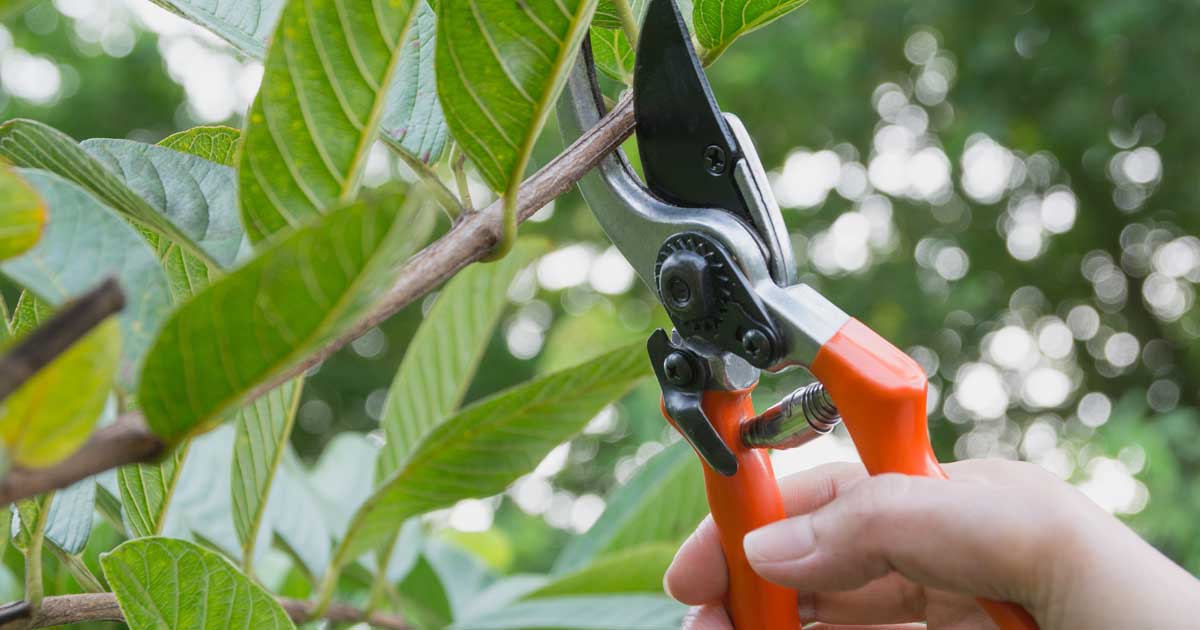
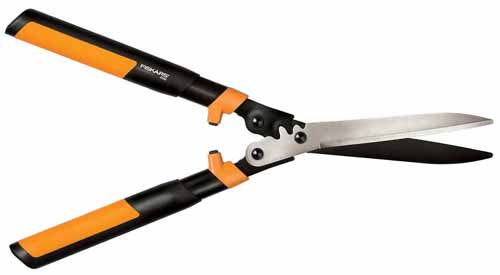
I’m glad you talked about what pruning is and why you should do it. I was really unclear on this before reading your article but I understand the importance of it all now! I’ll have to prune the three trees I have in my backyard so they stay healthy.
If you live in zone 7 or less, have slow growing plants, and like the look of naturally growing plants, why prune? For fruits and nuts I think it is OK. Prune for bigger and fewer flowers, or more and smaller ones. Let it be. Take away dead or sick branches. It is much better to give the plants room to grow and starting to cut them back because of your bad planning does not promote health. The same with topping, shearing, etc. Topiary gives more healthy plants? Topping gives more healthy plants? I have never seen these in nature.… Read more »
I got so much from this article. I am now aware of how to care for my perennials and also I now know that my lilac bush is a total loss ????. I have tried so much to bring it back and it just CONTINUES to get thinner and less flowers. I am going to dig it up and start over again. I am pretty new at this and I love it so very much. We have a large yard with so many options for beautiful gardens and I have convinced my fiance to buy more perennials this year VERSUS… Read more »
Thank you Mike, very helpful and easy to understand.
This is a brilliant article and I will keep reading. One thing I couldn’t see was sometimes they say cut 1 in 3 stems to ground level – does this mean I begin at the top and work down to ground level? Just want to be clear. I have already made up an excel sheet with all my info on each plant. So useful to have, takes time but well worth it. Thanks
Hey Hazel! If I’m understanding the question correctly, you’re asking if you should remove the entire stem at one time or in smaller sections. The answer, as always, is… it depends! What does it depend on? The size of the stem you’re removing. We use what’s called a three point pruning technique when removing branches or limbs from trees. The reasoning behind it is, if we remove one entire limb with a single cut, we could damage the tree severely. Imagine a limb suddenly snapping and tearing the bark from healthy portions of a tree. Yikes! It’s… Read more »
I’m in North Florida. It’s summer. Euonymus shrubs were planted about 2 years ago and a couple have a limb shooting up much higher than the rest. Question: Can I go ahead and snip the eager limbs now and where do I snip? Thank you. Note: I still don’t see option to attach a photo.
Hello Linda Burns! If you hustle, you can clip the “eager limbs” now, but leave any major pruning until late winter or early spring. The general rule of thumb is to make the big, rejuvenating cuts prior to the end of early spring–so March or April in your area. Make sure to complete any other casual cuts and light shaping by August 1. The general idea is to give the plants time to heal from the mid-summer cuts before frost hits. I know your area may not even get frost this year, but always better to be safe than sorry,… Read more »
What chemical or medicine to apply on wounds after cutting branches for better pruning?
What kind of plants are you pruning, Sachin? Application of any type of protective product to the wounds is typically not required, though pruning sealer is available for trees and shrubs, as well as roses.
This is an informative post to be considered when doing tree pruning. Thanks a lot!
Wonderful article about pruning. Great tips to be considered in gardening.
Thank you for sharing us how to prune shrubs and woody plants.